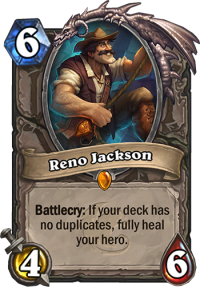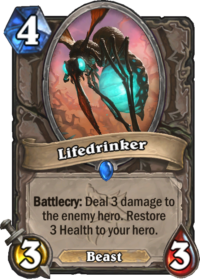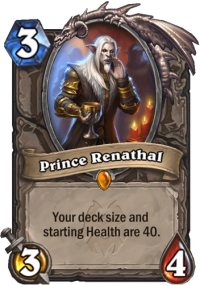In a game where the attacker has all the initiative and there are very few ways to disrupt your opponent’s actions, pure healing cards have been of fringe relevance for a very long time. In modern Hearthstone, the developers managed to find ways to make health increases relevant in Standard – albeit at a significant cost to other aspects of the game.
Back in My Day…

It’s always interesting to trace how Hearthstone’s own developers got to better understand the dynamics of their game over the years. Some of the design choices in the Classic set and the early expansions just didn’t make sense at the time, or ever since. The cards in question provided very little utility and grossly underestimated the importance of tempo, which was often irrecoverable in many of the faster matchups.
A good example of this is the various set of healing cards from the launch state of the game. Druid’s Healing Touch offered eight health for three mana, or Priestess of Elune in the neutrals, offering a whopping 4 HP for a 6 mana 5/4: it just wasn’t ever worth the investment. In fact, one of the easiest ways to improve Classic Mode’s Control Paladin deck, also known as “Healadin”, is to cut a couple of the superfluous healing cards.
The Role of Healing
There are very few ways to truly negate a tempo lead in Hearthstone, and healing definitely isn’t one of them. Even clearing an enemy’s board with a Flamestrike on turn 7 lets them immediately repopulate and push again should they have the cards to do so. Similarly – even more so, in fact – healing doesn’t negate tempo: it only buys you time. But time is often exactly what you need.

Even when the healing is as much as it can possibly get – like Tree of Life – is not good enough unless it is paired with a body. To make them relevant, healing effects had to be bundled with a large enough stat stick. Enter Antique Healbot, a 5-mana 3/3 that restored 8 health. Note how nobody called it a power creep of Priestess of Elune, by the way. The latter was useless to begin with, so the former’s introduction didn’t raise the bar: it merely cleared it.
The card was good – too good in the eyes of Team 5, especially once Brann Bronzebeard rolled around, as the prevalence of strong neutral healing effects disrupted certain class identities like Rogues, without any sort of deckbuilding restriction attached to it.
The next step in this evolution was, of course, Reno Jackson himself. Back in the days of the original League of Explorers, he was the sole payoff for building a Highlander deck, and it was good enough to do so in certain archetypes. This was later supercharged by the release of additional sets and the eventual arrival of Kazakus, a big heal bomb was already enough by itself, mainly for Warlocks, who could leverage the extra health by essentially turning it into added card draw.

Reno is actually a bit similar to Renathal – you sacrifice deck’s consistency (one is Highlander, the other is 40 cards) for the sake of extra health. However, unlike Renathal, Reno is more of a “bomb” card. While Price is incredibly consistent – after all you’re getting the extra health every turn – Reno is quite the opposite. His effect was even stronger than Renathal’s, and it could seal Aggro matchup on curve, but you need to draw (and have time to play) him first. Interestingly enough, both cards also synergize with each other. While you have to limit your deck even further (it’s 40 unique cards now), the combo is quite popular in Wild, as 40 health gives you more time to draw your important cards AND makes Reno’s effect stronger (you can now heal up to 39 instead of up to 29).
In those days, a 6-mana 4-6 was a relevant-enough presence on the board to complement the huge healing effect – and its relevancy is only underscored by the fact that no one really played in on turn 8 alongside a Youthful Brewmaster to double-dip on the effect. That, like Tree of Life, was just too slow.
Modern Healing: The Platinum Collection
Once Standard became a thing and the power levels were drawn down, healing effects became rarer for a while, especially in the neutral department. Cult Apothecary was a sad alternative to Antique Healbot, and Corrupted Healbot, well… that’s the point.
We haven’t seen any other neutral health restoration cards until Kobolds and Catacombs came around, and while Fungal Enchanter had a significant role to play in Heal Zoo decks, neither it nor Shroom Brewer’s targeted healing became relevant in the metagame.

The Witchwood changed the game again, pairing the effect with an aggressive core on Lifedrinker (which was used for its damage more than healing) and creating a strong relevant Taunt unit in the form of Rotten Applebaum. They were more narrowly defined and only viable in certain archetypes, but they both came with relevant stats and filled important roles. (Let’s ignore the people who ran Deranged Doctor in Constructed. They are over there in the corner.)
Again, nothing of note for a while, until Khartut Defender rolls around in Saviors of Uldum. Then, Darkmoon’s Circus Medic. Now, basically nothing in the current Standard rotation, at least in the neutral department – class cards, like Holy Maki Roll, made the effect super-cheap, and for a good reason.

Of course, this has a lot to do with the arrival of Prince Renathal, a very good reason to cut back on neutral healing tools that could further extend the longevity of decks playing with the card. It goes to show that potent neutrals with relevant healing effects can be super polarizing and relevant even in the modern state of the game, and something like Renathal, a card that essentially frontloads the heal, can have an even more significant impact. Unlike most of the healing cards, Renathal is not a tempo loss – yes, it makes your deck slightly worse overall, but it doesn’t cost you anything to get the extra 10 points of health. Not even that, extra healing is much better than health, because it means that you can heal back up over 30 and possibly even prevent some 30+ damage bursts.
Outside of a few classes specializing in it, healing was relatively uncommon in Hearthstone for years. Things have changed a lot with Renathal. Even though not exactly a healing card, he’s present in over 50% of the decks on ladder right now (and that’s after the recent Hunter nerf, which shaved that number by a good 10%). He does what healing cards are meant to do – buys time – but better.
In fact, the Prince’s head may soon be on the chopping block, if the previous patch notes are to be believed. As the developers stated, “he is powerful and popular, but we don’t want this patch to completely shake up the meta, because we have something fun coming in Patch 24.6 and we want to see how Renathal performs in the next expansion before making changes to him.” It will be interesting to see what that fun thing might be. Mayhaps a 10-mana 1/1 with Start of Game: Deal 10 damage to your opponent?

Healing aside, my first impression after the release of Renathal was that Hearthstone was moving toward decks of 40 cards adjusting heroes at 40 health, just that. Allowing more space for interesting cards to fill in and stronger decks to craft. A new player would come and meet Hearthstone finding this 40/40 scenario and have nothing special to object. Personally I see it as a proper adjustment to make the fight more fun, but if they want to go back perhaps they have different views.